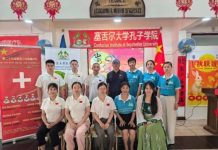Africa-Press – Seychelles. As interest in coral restoration grows among hotels worldwide, Nature Seychelles, a non-profit environmental organisation, has taken the lead in pioneering a new low-tech method to monitor the survival and growth of coral transplants.
This method has been published to make it accessible to people all over the globe.
To shed light on the specifics of this innovative method, press reached out to Dr Nirmal Shah, the chief executive of Nature Seychelles.
To understand the low-tech approach, we first need to grasp the conventional coral restoration process. In 2010, Nature Seychelles initiated a significant project to restore coral reefs in Seychelles, funded from overseas sources. It adopted a technique known as ‘coral gardening’ from scientific literature.
Dr Shah elaborated, “Small bits and pieces of live coral are attached to a rope, which we call rope nurseries, and left in the sea to grow. These rope nurseries, suspended on buoys, are carefully monitored and cleaned until the corals reach a certain size, after which they are transplanted. The process is akin to agricultural practices.”
When the corals attain the required size, they are then cemented to create colonies. Nature Seychelles devised a method using pastry bags or a specialised marine cement formula to attach the corals to the substrate, avoiding the previous approach of hammering nails into the reef. Once secured, the corals are left to grow.
Dr Shah emphasised that monitoring the corals after transplantation is of utmost importance due to potential threats such as predation by parrotfish, storm damage, and diseases. While their own team of divers effectively monitors restored reefs on Cousin Island, they faced challenges when working with non-biologists or staff in hotels where turnover is common. As a result, Nature Seychelles developed a technique during a reef restoration project on Praslin that, although providing limited data, proved effective in monitoring coral growth.
They attached a reflective ceramic tile to each coral using marine cement instead of traditional tagging, which was prone to algae growth. All the tiles were positioned uniformly so that snorkellers and divers from hotels could easily spot them. A map of the area was provided to guide them, and a camera was given to take monthly photos of the tile and coral.
The captured images are then sent to Nature Seychelles, where they can be used to assess the coral’s condition, whether it is alive, dead, or bleached. By measuring the growth using the dimensions of the tile, Nature Seychelles obtains valuable data.
Dr Shah pointed out that this method has been successfully employed with several hotels and represents the first-ever development of a technique for untrained staff. The idea arose from the need to establish basic parameters for monitoring and tackle the issue of people losing interest in long-term monitoring due to a lack of skills. Usually, coral reef restorations involve coral reef biologists who collect complex data on various parameters.
Nature Seychelles’ innovative low-tech approach is set to empower more individuals and establishments worldwide to contribute to coral restoration efforts effectively. By making monitoring simpler and more accessible, they hope to encourage continued engagement and ultimately foster the health and growth of coral reefs globally.
For More News And Analysis About Seychelles Follow Africa-Press






